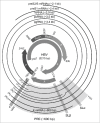Hepatitis B virus nuclear export elements: RNA stem-loop α and β, key parts of the HBV post-transcriptional regulatory element
- PMID: 27031749
- PMCID: PMC5013995
- DOI: 10.1080/15476286.2016.1166330
Hepatitis B virus nuclear export elements: RNA stem-loop α and β, key parts of the HBV post-transcriptional regulatory element
Abstract
Many viruses contain RNA elements that modulate splicing and/or promote nuclear export of their RNAs. The RNAs of the major human pathogen, hepatitis B virus (HBV) contain a large (~600 bases) composite cis-acting 'post-transcriptional regulatory element' (PRE). This element promotes expression from these naturally intronless transcripts. Indeed, the related woodchuck hepadnavirus PRE (WPRE) is used to enhance expression in gene therapy and other expression vectors. These PRE are likely to act through a combination of mechanisms, including promotion of RNA nuclear export. Functional components of both the HBV PRE and WPRE are 2 conserved RNA cis-acting stem-loop (SL) structures, SLα and SLβ. They are within the coding regions of polymerase (P) gene, and both P and X genes, respectively. Based on previous studies using mutagenesis and/or nuclear magnetic resonance (NMR), here we propose 2 covariance models for SLα and SLβ. The model for the 30-nucleotide SLα contains a G-bulge and a CNGG(U) apical loop of which the first and the fourth loop residues form a CG pair and the fifth loop residue is bulged out, as observed in the NMR structure. The model for the 23-nucleotide SLβ contains a 7-base-pair stem and a 9-nucleotide loop. Comparison of the models with other RNA structural elements, as well as similarity searches of human transcriptome and viral genomes demonstrate that SLα and SLβ are specific to HBV transcripts. However, they are well conserved among the hepadnaviruses of non-human primates, the woodchuck and ground squirrel.
Keywords: Covariance model; RNA secondary structure; hepadnavirus; stem-loop α; stem-loop β.
Figures


Similar articles
-
A conserved RNA structural element within the hepatitis B virus post-transcriptional regulatory element enhance nuclear export of intronless transcripts and repress the splicing mechanism.Mol Biol Rep. 2015 Dec;42(12):1603-14. doi: 10.1007/s11033-015-3928-0. Epub 2015 Oct 29. Mol Biol Rep. 2015. PMID: 26514143
-
The hepatitis B virus post-transcriptional regulatory element contains two conserved RNA stem-loops which are required for function.Nucleic Acids Res. 1998 Nov 1;26(21):4818-27. doi: 10.1093/nar/26.21.4818. Nucleic Acids Res. 1998. PMID: 9776740 Free PMC article.
-
Solution structure of stem-loop alpha of the hepatitis B virus post-transcriptional regulatory element.Nucleic Acids Res. 2008 Mar;36(5):1681-9. doi: 10.1093/nar/gkn006. Epub 2008 Feb 7. Nucleic Acids Res. 2008. PMID: 18263618 Free PMC article.
-
Insights into the nuclear export of murine leukemia virus intron-containing RNA.RNA Biol. 2015;12(9):942-9. doi: 10.1080/15476286.2015.1065375. RNA Biol. 2015. PMID: 26158194 Free PMC article. Review.
-
Prospects for inhibiting the post-transcriptional regulation of gene expression in hepatitis B virus.World J Gastroenterol. 2014 Jul 7;20(25):7993-8004. doi: 10.3748/wjg.v20.i25.7993. World J Gastroenterol. 2014. PMID: 25009369 Free PMC article. Review.
Cited by
-
RNR-R2 Upregulation by a Short Non-Coding Viral Transcript.Biomolecules. 2021 Dec 3;11(12):1822. doi: 10.3390/biom11121822. Biomolecules. 2021. PMID: 34944466 Free PMC article.
-
The Post-Transcriptional Regulatory Element of Hepatitis B Virus: From Discovery to Therapy.Viruses. 2024 Mar 29;16(4):528. doi: 10.3390/v16040528. Viruses. 2024. PMID: 38675871 Free PMC article.
-
Neoantigen-specific CD4+ T cells in human melanoma have diverse differentiation states and correlate with CD8+ T cell, macrophage, and B cell function.Cancer Cell. 2022 Apr 11;40(4):393-409.e9. doi: 10.1016/j.ccell.2022.03.006. Cancer Cell. 2022. PMID: 35413271 Free PMC article.
-
Mitochondrial DNA is a target of HBV integration.Commun Biol. 2023 Jul 3;6(1):684. doi: 10.1038/s42003-023-05017-4. Commun Biol. 2023. PMID: 37400627 Free PMC article.
-
Endogenous CD4+ T Cells Recognize Neoantigens in Lung Cancer Patients, Including Recurrent Oncogenic KRAS and ERBB2 (Her2) Driver Mutations.Cancer Immunol Res. 2019 Jun;7(6):910-922. doi: 10.1158/2326-6066.CIR-18-0402. Epub 2019 May 1. Cancer Immunol Res. 2019. PMID: 31043415 Free PMC article.
References
-
- Chen A, Kao YF, Brown CM. Translation of the first upstream ORF in the hepatitis B virus pregenomic RNA modulates translation at the core and polymerase initiation codons. Nucleic Acids Res 2005; 33:1169-81; PMID:15731337; http://dx.doi.org/10.1093/nar/gki251 - DOI - PMC - PubMed
-
- Chen A, Panjaworayan T-Thienprasert N, Brown CM. Prospects for inhibiting the post-transcriptional regulation of gene expression in hepatitis B virus. World J Gastroenterol WJG 2014; 20:7993-8004; PMID:25009369; http://dx.doi.org/10.3748/wjg.v20.i25.7993 - DOI - PMC - PubMed
-
- Doitsh G, Shaul Y. A long HBV transcript encoding pX is inefficiently exported from the nucleus. Virology 2003; 309:339-49; PMID:12758180; http://dx.doi.org/10.1016/S0042-6822(03)00156-9 - DOI - PubMed
-
- Smith GJ, Donello JE, Hope TJ, Lück R, Steger G. The hepatitis B virus post-transcriptional regulatory element contains two conserved RNA stem-loops which are required for function. Nucleic Acids Res 1998; 26:4818-27; PMID:9776740; http://dx.doi.org/10.1093/nar/26.21.4818 - DOI - PMC - PubMed
-
- Chen A, Brown CM. Distinct families of cis-acting RNA replication elements epsilon from hepatitis B viruses. RNA Biol 2012; 9:130-6; PMID:22418844; http://dx.doi.org/10.4161/rna.18649 - DOI - PMC - PubMed
Publication types
MeSH terms
Substances
LinkOut - more resources
Full Text Sources
Other Literature Sources
